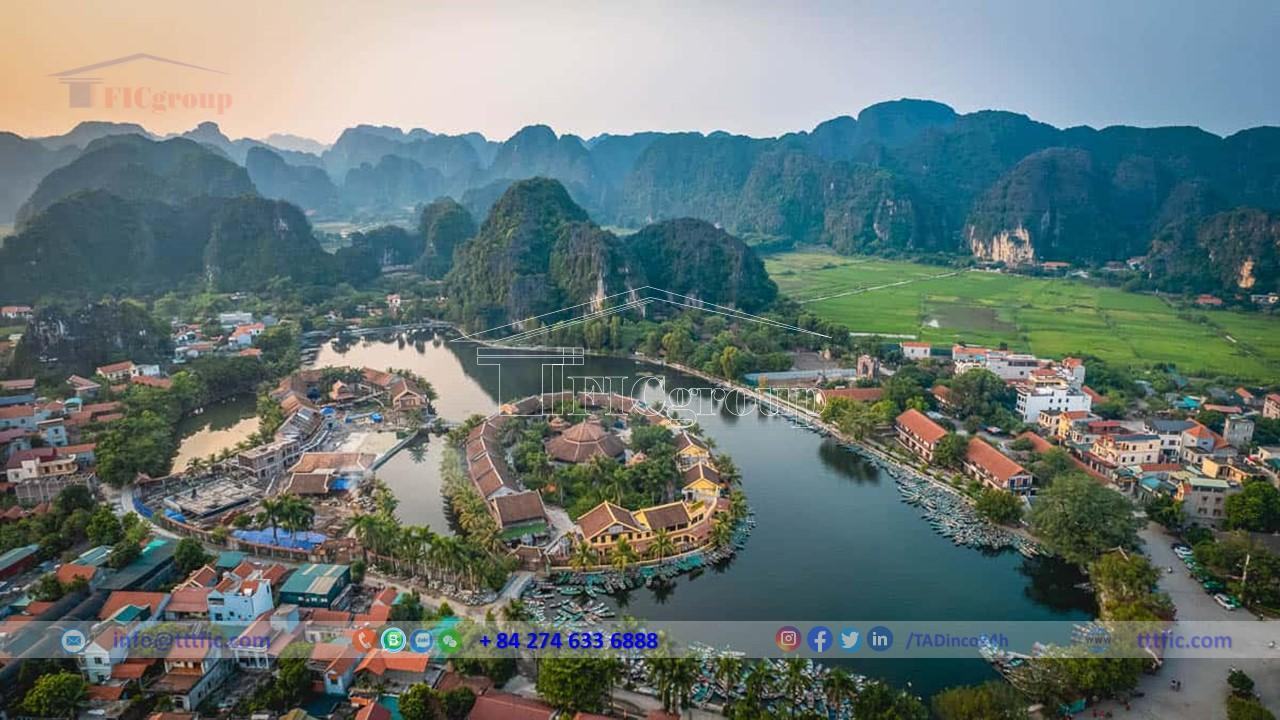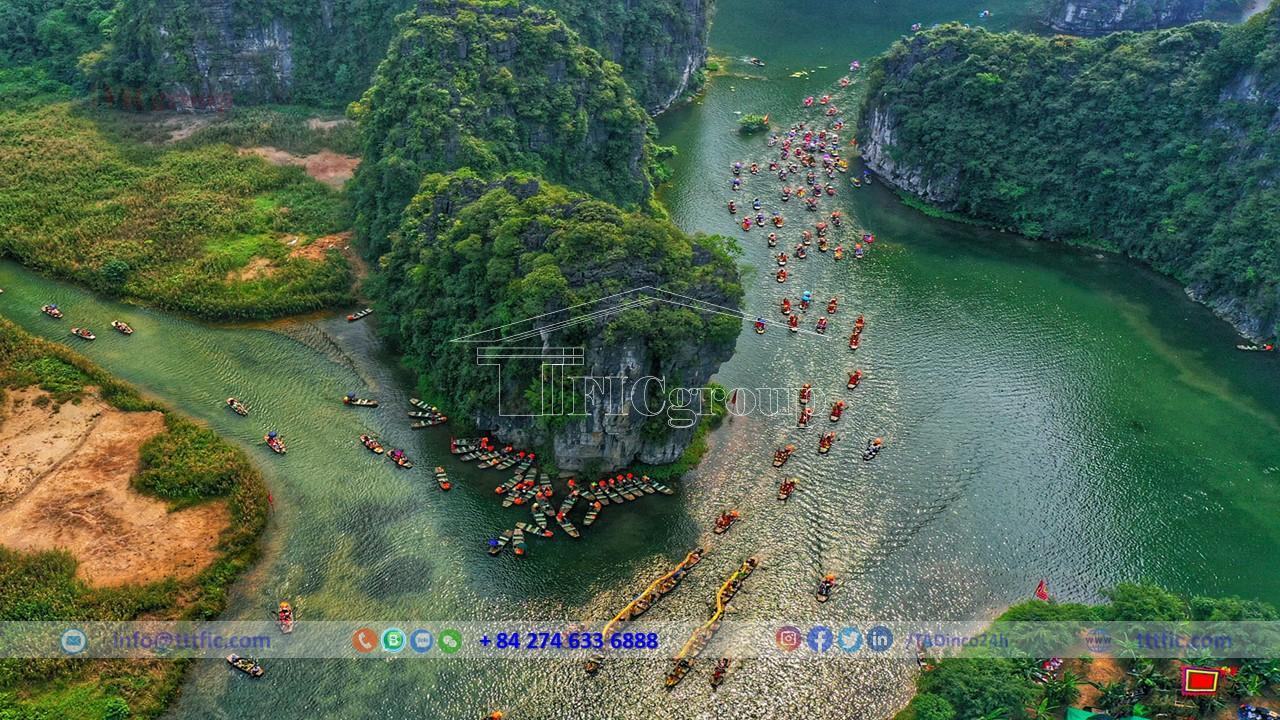Overview of Ninh Binh province:
Ninh Binh province, situated in the Red River Delta, is a province located in the southernmost part of northern Vietnam. In 2021, it ranked 44th in population and 21st in Gross Regional Domestic Product (GRDP) among Vietnamese administrative units. The province’s population is approximately 973,300, with a GRDP of 85,035 billion Vietnamese Dong (equivalent to 3.61 billion USD). The per capita GRDP is 72.04 million Vietnamese Dong (equivalent to 3,118 USD), and the GRDP growth rate reached 5.71%.
Although Ninh Binh belongs to the Red River Delta region, only two districts, Kim Son and Yen Khanh, have flat terrains. The economic development plan places Ninh Binh in the North Coastal region. Historically, Ninh Binh was the capital of Vietnam during the 968-1010 period, under the rule of the Dinh, Early Le, and Ly dynasties. It has also played a significant role in military affairs throughout different historical periods. With its exceptional geographical location, terrain, and rich cultural history, along with two UNESCO World Heritage sites and a biosphere reserve, Ninh Binh has emerged as a potential and diverse tourist destination. Additionally, it is the first province in the Red River Delta to have two dependent cities: Tam Diep and Ninh Binh.
Geography of Ninh Binh province:
Geographical location:
Ninh Binh, a province in Vietnam, occupies a strategic location at the intersection of three geographic regions: the Northwest, Red River Delta, and North Central Coast. Additionally, it is positioned between three major economic zones: Hanoi, the North Coastal region, and the Central Coastal region. Ninh Binh serves as a pivotal hub in northern Vietnam, connecting provinces from Thua Thien Hue onwards. Ha Nam province shares its northern border with Ninh Binh province, while the Day River marks the eastern and northeastern boundaries, separating it from Nam Dinh province.. The province’s northwest border adjoins Hoa Binh province, and to the south, it is adjacent to Thanh Hoa province and the Gulf of Tonkin (Bac Bo Gulf), boasting the country’s shortest coastline of 18 kilometers.
Notably, Ninh Binh possesses several extreme points within its territory, including an easternmost point at Do Muoi Port in Khanh Thanh commune, Yen Khanh district, a westernmost point in Cuc Phuong Forest, Nho Quan district, a southernmost point near Kim Dong commune, Kim Son district, and a northernmost point in the mountainous area of Xich Tho commune, Nho Quan district. The province’s administrative center is the city of Ninh Binh, positioned 93 kilometers to the south of Hanoi, the capital city. Additionally, Tam Diep city is located 105 kilometers away from Hanoi.
Natural condition:
Topographic:
Ninh Binh, located at the junction of the Red River Delta, encompasses three types of terrain. The northwestern region consists of hills and semi-mountainous areas, including Nho Quan, Gia Vien, Hoa Lu, and Tam Diep. The highest peak, May Bac, reaches 648 meters in the Cuc Phuong Forest. The southeastern coastal plain belongs to Kim Son and Yen Khanh districts, featuring natural lakes such as Dong Chuong, Mot den Bon Yen Quang, Yen Thang, Mua Thu, Da Lai, and Dong Thai. The transitional valley region lies between the two major areas.
Ninh Binh’s forests include both production and special-use forests, including Cuc Phuong, Van Long Environmental Forest, Hoa Lu Cultural-Historical Environment, and Coastal Conservation Forests in Kim Son. The Hoa Lu-Trang An Special-Use Forest has been recognized by UNESCO as part of the Trang An Scenic Landscape Complex, a World Heritage Site. Ninh Binh has an 18-kilometer coastline, the shortest in Vietnam, which expands over 100 meters annually due to sediment deposition. UNESCO has designated the coastal and marine areas of Ninh Binh as World Biosphere Reserves.. The province is also home to two islands: Con Noi and Con Mo.
Ninh Binh experiences a humid subtropical climate, characterized by hot and humid summers, with the rainy season from June to October. It is the only province in the northern region where the rainy season extends into October. The dry and cold winter lasts from November to March, while April and October mark the spring and autumn seasons, although less distinct than in the tropical belt. The average annual rainfall ranges from 1,700 to 1,900 mm, with an average temperature of 23.5°C. Ninh Binh enjoys 1,600 to 1,700 hours of sunshine per year and an average relative humidity of 80-85%.

Natural resource:
The province of Ninh Binh boasts abundant limestone resources that span a vast area from the northwest to the southeast, covering Nho Quan, Gia Vien, Hoa Lu, Tam Diep, Yen Mo, and extending to the East Sea. These limestone formations stretch over 40 km and occupy an area of more than 12,000 hectares, containing immense reserves of limestone and dolomite. These reserves play a crucial role in producing cement, construction materials, and chemicals.
In addition, scattered clay deposits in Yen Son, Yen Binh (Tam Diep), Gia Vien, and Yen Mo contribute to the production of bricks, tiles, and casting materials.
Ninh Binh is famous for its high-quality mineral water, mainly found in Cuc Phuong (Nho Quan) and Kenh Ga (Gia Vien).The province can utilize this valuable resource for the production of biofertilizers, thereby supporting agricultural activities. Kenh Ga mineral water, known for its distinctive salty taste, maintains a constant temperature of around 53-54°C. Cuc Phuong mineral water, with its high content of magnesium bicarbonate, finds application in beverages and medicinal treatments.
Furthermore, the province possesses over 2 million tons of mud coal reserves distributed in Gia Son, Son Ha (Nho Quan), and Quang Son (Tam Diep). The province can utilize this valuable resource for the production of biofertilizers, thereby supporting agricultural activities.
Economy of Ninh Binh province:
In 2022, the province is estimated to achieve a Gross Regional Domestic Product (GRDP) of 49,638.8 billion Vietnamese dong, based on the 2010 price index, reflecting a growth of 8.62% compared to 2021. Furthermore, the growth in different sectors contributes as follows:
Sector I, which includes agriculture, forestry, and fisheries, is projected to contribute 4,526.2 billion dong, with a growth rate of 3.04%, accounting for 0.29 percentage points of the overall economic growth.
In addition, Sector II, encompassing industry and construction, is estimated to contribute 18,421.3 billion dong, with a growth rate of 5.67%. Notably, the industrial sector alone is expected to contribute 14,169.0 billion dong, with a growth rate of 5.96%, accounting for 1.74 percentage points of the overall growth.
Moreover, Sector III, comprising services, is anticipated to contribute 17,950.5 billion dong, with a growth rate of 15.45%, contributing 5.26 percentage points to the overall growth.
Additionally, tax revenue, excluding product subsidies, is estimated to reach 8,740.8 billion dong, with a growth rate of 4.99%, contributing 0.91 percentage points to the overall growth.
These figures demonstrate the positive economic development and significant contributions from various sectors in the province’s overall Gross Regional Domestic Product in 2022.

Social:
Residential:
Ninh Binh province covers an area of 1,400 km² with a population of 982,487 people (according to the April 1, 2019 population census). 28.1% of the population lives in urban areas, while 71.9% resides in rural areas, resulting in a population density of 642 people/km².
As of April 1, 2019, the province has a total of 71,031 followers of different religions. The majority is Catholic with 36,161 followers, followed by Buddhism with 35,968 followers. Other religions include Protestantism with five followers, Islam with three followers, and Caodaism with two followers.
By December 31, 2020, the total population of Ninh Binh province reached 993,920 people, consisting of 495,995 males and 497,925 females.
Heathcare – education:
In the healthcare sector, Ninh Binh has two military hospitals: Military Hospital 5 of the 3rd Military Region and Military Hospital 145 of the 1st Corps.
The province also has seven provincial-level hospitals:
– Ninh Binh General Hospital
– Traditional Medicine Hospital of Ninh Binh Province (100 beds)
– Ninh Binh Tuberculosis and Lung Disease Hospital (100 beds)
– Ninh Binh Mental Hospital (100 beds)
– Rehabilitation and Functional Recovery Hospital (100 beds)
– Ninh Binh Obstetrics and Pediatrics Hospital (200 beds)
– Ninh Binh Eye Hospital (50 beds).
In terms of education and training, the province is home to Hoa Lu University and five colleges:
– Ninh Binh Vocational College of Mechanics
– LILAMA-1 Vocational College
– Ninh Binh Medical College
– Vocational College No. 13
– Tam Diep Vocational College of Electromechanical Construction.
For several consecutive years, Ninh Binh students have consistently ranked among the top 10 provinces and cities in university and college entrance exams. They have achieved impressive average scores in various subjects: 2nd out of 63 provinces and cities in 2013, 4th in 2014, 4th in 2015, 4th in 2016, 3rd in 2017, 3rd in 2018, 2nd in 2019, and 3rd in 2020.





